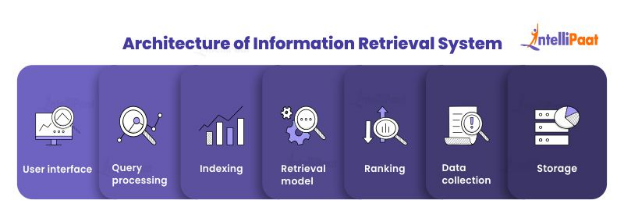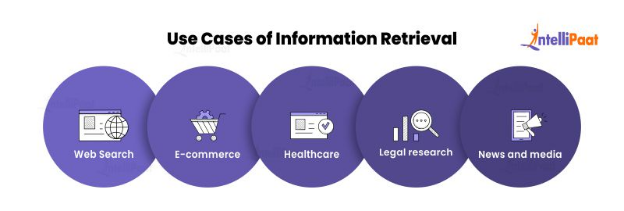What is Information Retrieval?
We can now rapidly and effectively search, retrieve, and make sense of enormous volumes of data. All this is possible due to the development of a variety of technologies and techniques in the field of IR.
Given below are the topics that we are going to explain in this blog.
- Introduction to Information Retrieval
- Necessity for Information Retrieval
- Components of Information Retrieval
- Architecture of Information Retrieval System
- Use Cases of Information Retrieval
- Conclusion
Watch this Artificial Intelligence Video Tutorial for Beginners:
{
“@context”: “https://schema.org”,
“@type”: “VideoObject”,
“name”: “Artificial Intelligence Tutorial | Artificial Intelligence Course | Intellipaat”,
“description”: “What is Information Retrieval?”,
“thumbnailUrl”: “https://img.youtube.com/vi/UkZzM-jxLv4/hqdefault.jpg”,
“uploadDate”: “2023-05-18T08:00:00+08:00”,
“publisher”: {
“@type”: “Organization”,
“name”: “Intellipaat Software Solutions Pvt Ltd”,
“logo”: {
“@type”: “ImageObject”,
“url”: “https://intellipaat.com/blog/wp-content/themes/intellipaat-blog-new/images/logo.png”,
“width”: 124,
“height”: 43
}
},
“contentUrl”: “https://www.youtube.com/watch?v=UkZzM-jxLv4”,
“embedUrl”: “https://www.youtube.com/embed/UkZzM-jxLv4”
}
Introduction to Information Retrieval
The process of searching and obtaining pertinent information from a set of data is known as Information Retrieval (IR). In this digital era, the availability of information is quickly expanding, thus making it increasingly challenging to obtain the appropriate information at the appropriate moment. For such a massive volume of data to be managed, successfully and efficiently, IR is crucial.
Indexing, searching, and rating are just a few of the operations that go into the process of retrieving information. While searching entails the execution of a query on the catalog to locate pertinent information, indexing entails the creation of a catalog of the information that is to be explored. Some examples of IR systems include recommendation systems, text mining, and natural language processing.
Dive deep into the world of AI through Intellipaat’s Artificial Intelligence Course.
Necessity for Information Retrieval
The enormous volume of data that is created and stored every day has made the need for IR more crucial. Since the creation of the internet and the development of digital technologies, the amount of information at our disposal has multiplied, by leaps and bounds.
It has become challenging for people and organizations to locate pertinent information, quickly and effectively, in such a situation. IR can help with this. Users may quickly and effectively locate pertinent information from a vast volume of data through IR.
It makes it possible for people and organizations to have timely access to the information that is necessary for making wise decisions. Researchers and scientists may keep current on advancements by utilizing IR to gain access to the most recent literature, data, and analysis in their area of expertise.
Wish to gain in-depth knowledge of AI? Check out our Artificial Intelligence Tutorial, and gather more insights!
Components of Information Retrieval
IR is a multi-step process, comprising several different elements. The principal elements of IR are enumerated below:
Document collection:
This process entails the collection of papers that need to be searched. It can originate from a variety of sources, such as web pages, papers, books, and other forms of text-based data.
Indexing:
Making an index of the collection of documents is what the indexing phase comprises. This index typically contains a list of every term that is used in the document collection, along with its frequency and location.
Query processing:
This process is a part of the system that transforms user queries into a format that can be utilized to search the index. Sub-components like the parsing, expansion, and rewriting of queries may be included in this component.
Retrieval model:
The retrieval model determines how the documents are retrieved and ranked in response to a user query. Retrieval models come in a variety of forms, such as probabilistic, vector-space, and Boolean models.
Ranking:
Based on how relevant the papers are to the user’s query, the ranking component chooses the order in which these papers are shown to the user. The retrieval model is often used by the ranking component to determine the relevance score of each document, which is subsequently used to order the documents.
Presentation:
The user’s view of the search results is provided by the presentation component. This might involve the display of the findings as a document list, document summary, or as visualizations, like graphs or charts.
For a deep understanding of AI types, you can read our comprehensive blog on Types of Artificial Intelligence.
Architecture of Information Retrieval System

The architecture of an IR system typically includes the following components:
- User interface: This component enables user interaction with the system. Filters, search box, and other tools may be included in it so that the users may input their queries and hone the search results.
- Query processing: The query processing component transforms processed user queries into a form that may be utilized to search the index. The parsing, expansion, and rewriting of queries are just a few examples of its possible sub-components.
- Indexing: Making an index of the document collection is the indexing component’s responsibility. All the terms involved in the document collection are normally listed in this index, together with the information about how frequently and where they appear.
- Retrieval model: In order to obtain and rank documents in response to a user query, the retrieval model must be used. Boolean, vector-space, and probabilistic models are only a few of the various retrieval models available.
- Ranking: The ranking element chooses the order in which the pages are displayed to the user, depending on how relevant they are to the query. A relevance score is generally calculated for each document by the ranking component using the retrieval model, and the documents are then sorted according to the score.
- Data collection: A document collection is a set of papers that must be searched. It may include a variety of sources, including written materials like books, journals, and websites.
- Storage: The document collection, index, and other data that the system requires to execute searches and retrievals are held in the component that handles storage.
Check out these Artificial Intelligence Interview Questions if you’re preparing for a Job interview.
Use Cases of Information Retrieval

There are several use cases for IR spanning numerous fields and programs. Here are some instances of how the IR is applied in various situations:
Web Search:
Web search is the most typical application of IR. In order to gather and display consumers with pertinent information, depending on their queries, search engines like Google and Bing employ IR methods.
E-commerce:
To assist customers in finding things that they are interested in, online marketplaces like Amazon and eBay employ IR. In order to rank items, according to their relevance, IR methods are employed to search for and retrieve product information, based on user queries.
Healthcare:
IR is employed by the healthcare industry to locate pertinent medical data in databases and electronic health records. Doctors and researchers who need to make judgments about their patient’s care and treatment methods can use this knowledge to their advantage.
Legal research:
To find and retrieve pertinent case laws, legal papers, and other legal material, attorneys and other legal professionals utilize IR.
News and media:
To find and retrieve pertinent news items and other media material, news organizations employ IR. This enables them to stay up to date on current affairs and give their audience correct information at the appropriate moment.
Career Transition
Conclusion
Information retrieval (IR) is used in a broad variety of applications and sectors. Organizations may swiftly and effectively find and retrieve pertinent information by adopting IR strategies that are proven to result in better decision-making, enhanced customer experiences, and higher productivity.
For more information on Artificial intelligence, visit our AI Community.
The post What is Information Retrieval? appeared first on Intellipaat Blog.
Blog: Intellipaat - Blog
Leave a Comment
You must be logged in to post a comment.












